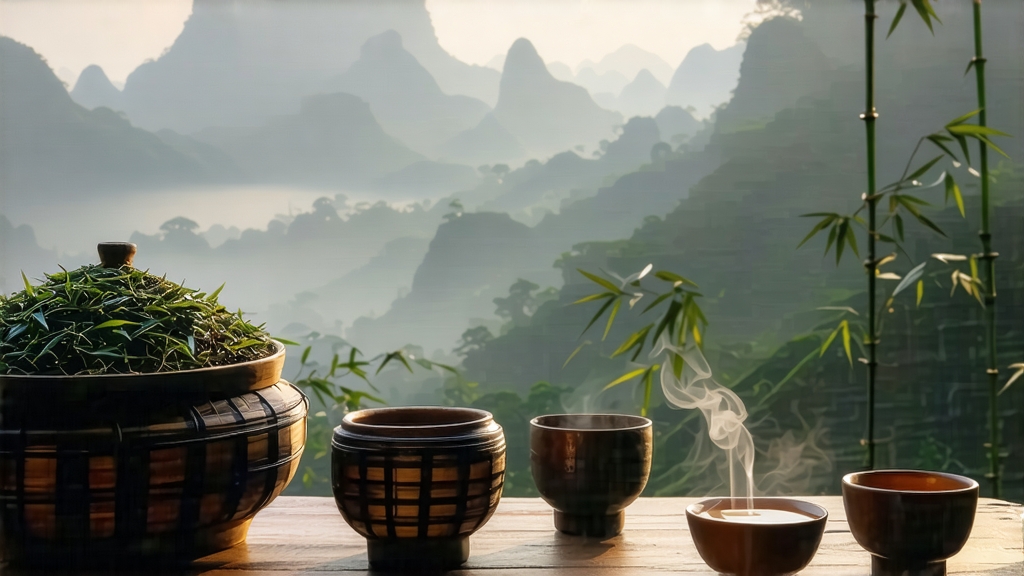
Tucked away in the humid, karst-pocked mountains of southern China’s Guangxi Zhuang Autonomous Region, Liu Bao tea has spent the last four centuries quietly perfecting the art of controlled aging. To most Western palates “dark tea” still means the smoky bricks carried on the Ancient Tea Horse Road, yet Liu Bao offers a softer, more aromatic face of post-fermentation—one that smells of damp rainforest, longan fruit and, curiously, fresh betel nut. This article invites you to journey from the Qing-dynasty docks of Wuzhou to the modern gongfu table, tracing how a humble borderland leaf became one of China’s most cellar-worthy beverages.
-
Historical footprints
Liu Bao takes its name from the small administrative village of Liu Bao in Cangwu County, Wuzhou Prefecture. During the Ming-Qing transition, local growers discovered that tea shipped down the Liu Bao creek to the Xi Jiang River acquired a mellow sweetness after weeks in humid bamboo baskets. By the Qianlong era (1736-1795) the tea was listed in the imperial “Gong Cha” (tribute tea) register, traveling north to Beijing via the Grand Canal. Overseas, it rode the same junks that carried opium and porcelain to British Hong Kong and then to Malaya, where tin-mining coolies prized it for dissolving the greasy “kongsi” diet. In Kuala Lumpur’s old Chinese medicine halls you can still find 1950s baskets bearing the chop “Liu Bao Lao Cha”—proof that the tea had already become a diaspora comfort long before pu-erh’s global fame. -
Terroir and leaf
Guangxi’s subtropical monsoon climate gives Liu Bao its microbial edge: 1,500 mm of yearly rainfall, average humidity above 78 %, and red lateritic soil rich in kaolin and iron. The indigenous cultivar is the medium-leaf “Cangwu Qunti,” a sexually reproducing population rather than a cloned bush, hence broader genetic diversity for microbial fermentation. Leaves are picked as one bud-with-three-leaves in late April, when amino acids peak but astringent catechins have not yet rocketed under summer sun. -
Crafting the darkness
Liu Bao belongs to the “hou fa jiao” (post-fermented) family, yet its roadmap differs markedly from Yunnan’s shou pu-erh. After plucking, the leaf undergoes:
a) Indoor withering on bamboo racks for 8-10 h to reduce moisture to 65 %.
b) Kill-green in a 200 °C drum for 3 min—longer than green tea but shorter than oolong—to preserve oxidative enzymes that will matter later.
c) Rolling under light pressure to crack cell walls without stripping fuzz.
d) Sun-drying on courtyards of red clay, where ultraviolet rays trigger non-enzymatic browning.
e) The signature “wo dui” (wet piling): leaves are sprayed to 35 % moisture, heaped 70 cm high, and covered with jute sacks. Internal temperature climbs to 55 °C within 36 h; every 48 h the pile is turned and restacked. Over 10-15 days thermophilic microbes—Aspergillus, Bacillus, and the yeast Cyberlindnera—convert catechins into theabrownins and gallic acid, gifting the deep amber liquor and throat-coating sweetness.
f) Compression into 40 kg bamboo baskets lined with wild banana leaf. The bamboo’s natural lactobacilli inoculate the tea for decades, while the banana leaf imparts a faint estery note reminiscent of jackfruit.
g) Storage in “tea cellars” dug into hillsides: constant 24 °C and 85 % humidity, like a cigar cave but with more mycelial chatter. A 1996 basket I tasted in 2022 had lost all greenish astringency, yielding instead notes of camphor, nutmeg and dried longan. -
Stylistic spectrum
- Young Liu Bao (1-3 years): woody, slightly smoky, bright red liquor.
- Aged Liu Bao (10-20 years): betel-nut bouquet, “chen xiang” (old-book mustiness), thick broth that clings to the cup’s rim like PX sherry.
- “Gold flower” Liu Bao: